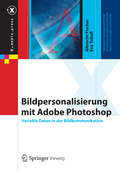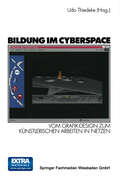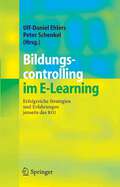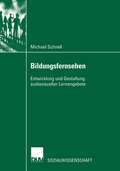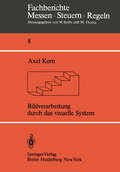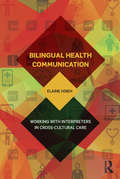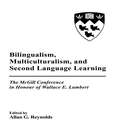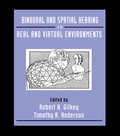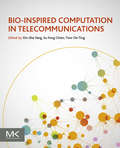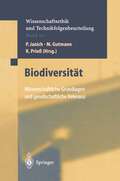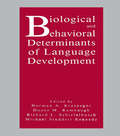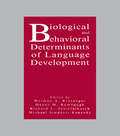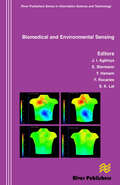- Table View
- List View
Bildpersonalisierung mit Adobe Photoshop: Variable Daten in der Bildkommunikation (X.media.press)
by Albrecht Fischer Eva ToballDas Buch gibt eine detaillierte Anleitung zur Erstellung von Bildvorlagen für die Personalisierung und zeigt eine Vielzahl kreativer Gestaltungsmöglichkeiten auf. Durch den Einsatz eines Skripts können Individualisierungen ohne zusätzliche Programmierkenntnisse direkt in Adobe Photoshop realisiert werden. Personalisierte Bilder erzielen eine hohe Aufmerksamkeit und steigern die Wirkung von Werbemitteln um ein Vielfaches. Oft werden hierzu proprietäre Programme eingesetzt, die den Gestaltungsspielraum des Anwenders einschränken. Die Verwendung von variablen Daten ermöglicht hingegen die Umsetzung grafisch anspruchsvoller Projekte mit Adobe Photoshop. Das Buch will dazu beitragen, Bildpersonalisierung primär als eine grafische und nicht als eine programmiertechnische Aufgabe zu sehen. Es ist damit ein Plädoyer für mehr Kreativität und mehr gestalterische Qualität in der Bildpersonalisierung. Eine Demoversion des eingesetzten Automatisierungsskripts steht online zur Verfügung.
Bildsampling: Wie viele Bilder brauchen wir? (Bildwissenschaft)
by Martin Scholz Ute HelmboldSieben AutorInnen aus Design, Kunstgeschichte, Film und Illustration beleuchten individuelle und generelle Aspekte der mehrfachen Verwendung von Bildern. Sie fokussieren insbesondere auf die Konsequenzen, die für Bildhersteller und -gestalter aus der praktischen Wiederverwendung entstehen.
Bildung im Cyberspace: Vom Grafik-Design zum künstlerischen Arbeiten in Netzen. Entwicklung und Erprobung eines Weiterbildungskonzeptes. Projektband 1
by Deutsches Inst. f. ErwachsenenbildungDie Verbreitung "neuer", computergestützter Medien verändert das Potenzial, Wissen zu erwerben und zu kommunizieren. So kann im Internet Bildungswissen individuell und außerhalb etablierter Bildungsinstitutionen erworben werden. Zugleich bietet sich den Nutzern die Möglichkeit, als Medienproduzenten selbstgestalteter Inhalte aufzutreten. Hierzu sind jedoch technische und kulturelle Kompetenzen im Umgang mit den neuen Medien Voraussetzung. Der vorliegende Band beleuchtet die Problematik kreativer Medienkompetenz als Grundlage einer erweiterten Bildung aus interdisziplinären Blickwinkeln und mit empirischem Bezug zu einem Modellprojekt der kulturellen Bildung, das von Bundesministerium für Wissenschaft, Forschung und Technologie unterstützt und vom Deutschen Institut für Erwachsenenbildung e.V. in Kooperation mit dem Institut für Neue Medien sowie verschiedenen Bildungseinrichtungen durchgeführt wurde.
Bildungscontrolling im E-Learning: Erfolgreiche Strategien und Erfahrungen jenseits des ROI
by Ulf-Daniel Ehlers Peter SchenkelWer den Inhalt des Begriffs „Berufsbildung“ über einen längeren Zeitraum verfolgt, kann fasziniert beobachten, wie sich die Anforderungen der Wi- schaft immer stärker durchsetzen. Bildung erscheint als ein Relikt der 50er Jahre, einer Zeit, in der man es sich noch leisten konnte, auf „Philo- phien“ des vergangenen Jahrhunderts zurückzugreifen. Einmal beschritten, scheint der Weg von Bildung über Qualifikationen, Qualifikationsanfor- rungen, zur Performance unumkehrbar. Denn nur mit einer eindeutigen - xierung der Berufsbildung auf Umsatz und Ertrag können Unternehmen und Beschäftigte in Zeiten weltweiter Konkurrenz bestehen. E-Learning hat diese Entwicklung weiter gefördert. Die Unterstützung von Bildungsprozessen durch Technologien wurde vorangetrieben durch die Hoffnung, Kosten zu sparen, Lernzeiten zu reduzieren und Bildungs- halte jederzeit und ganz genau an die Anforderungen der Unternehmen - zupassen. Bei den dafür erforderlichen hohen Investitionen in Hard- und Software liegt es nahe, die Wirtschaftlichkeit dieser Investitionen mit den gleichen Rechnungen nachzuweisen, die auch für den Nachweis der Wi- schaftlichkeit anderer Investitionen eingesetzt werden. Und damit sind wir beim Thema dieses Buches.
Bildungsfernsehen: Entwicklung und Gestaltung audiovisueller Lernangebote
by Michael SchnellMichael Schnell zeigt umfassende Anregungen und Richtlinien aus der Forschungslandschaft auf, wie audiovisuelle Lernumgebungen im Rahmen von Fernseh- und computerbasierten Lernangeboten entwickelt und gestaltet werden sollen, um einen möglichst großen Lerneffekt zu erzielen.
Bildverarbeitung in der Automation: Ausgewählte Beiträge des Jahreskolloquiums BVAu 2022 (Technologien für die intelligente Automation #17)
by Volker LohwegIn diesem Open-Access-Tagungsband sind die besten Beiträge des 8. Jahreskolloquiums "Bildverarbeitung in der Automation" (BVAu 2022) enthalten. Das Kolloquium fand am 02. November 2022 auf dem Innovation Campus Lemgo statt.Die vorgestellten neuesten Forschungsergebnisse auf den Gebieten der industriellen Bildverarbeitung erweitern den aktuellen Stand der Forschung und Technik. Die in den Beiträgen enthaltenen anschaulichen Anwendungsbeispiele aus dem Bereich der Automation setzen die Ergebnisse in den direkten Anwendungsbezug.
Bilingual Health Communication: Working with Interpreters in Cross-Cultural Care
by Elaine HsiehThis book examines interpreter-mediated medical encounters and focuses primarily on the phenomenon of bilingual health care. It highlights the interactive and coordinated nature of interpreter-mediated interactions. Elaine Hsieh has put together over 15 hours of interpreter-mediated medical encounters, interview data with 26 interpreters from 17 different cultures/languages, 39 health care providers from 5 clinical specialties, and surveys of 293 providers from 5 clinical specialties. The depth and richness of the data allows for the presentation of a theoretical framework that is not restricted by language combination or clinical contexts. This will be the first book of its kind that includes not only interpreters’ perspectives but also the needs and perspectives of providers from various clinical specialties. Bilingual Health Communication presents an opportunity to lay out a new theoretical framework related to bilingual health care and connects the latest findings from multiple disciplines. This volume presents future research directions that promise development for both theory and practice in the field.
Bilingual Health Communication: Working with Interpreters in Cross-Cultural Care
by Elaine HsiehThis book examines interpreter-mediated medical encounters and focuses primarily on the phenomenon of bilingual health care. It highlights the interactive and coordinated nature of interpreter-mediated interactions. Elaine Hsieh has put together over 15 hours of interpreter-mediated medical encounters, interview data with 26 interpreters from 17 different cultures/languages, 39 health care providers from 5 clinical specialties, and surveys of 293 providers from 5 clinical specialties. The depth and richness of the data allows for the presentation of a theoretical framework that is not restricted by language combination or clinical contexts. This will be the first book of its kind that includes not only interpreters’ perspectives but also the needs and perspectives of providers from various clinical specialties. Bilingual Health Communication presents an opportunity to lay out a new theoretical framework related to bilingual health care and connects the latest findings from multiple disciplines. This volume presents future research directions that promise development for both theory and practice in the field.
Bilingualism, Multiculturalism, and Second Language Learning: The Mcgill Conference in Honour of Wallace E. Lambert
by Allan G. ReynoldsThis collection pays tribute to Professor Wallace E. Lambert and his contributions to the fields of language and linguistics. Each chapter, written by an internationally renowned theorist or researcher, traces the currents of theory and research within the topic area to the present day, provides a state-of-the-art review of the topic, and offers an outline for future research directions. The book concludes with an overview from Professor Lambert that critically examines the impact of the ideas in each individual chapter. This volume is organized around the three areas where Professor Lambert's unique contributions are most substantial and most evident: bilingualism, multiculturalism, and second language learning. Specifically, the papers presented discuss the topics of social, psychological, cognitive, and neuropsychological aspects of bilingualism and second language learning, the psychology of inter-group relations and multiculturalism, bilingual/immersion education, and language planning. Note: Royalties earned from sales of this book will go to the Wallace E. Lambert Student Research Fund at McGill University for use by students interested in second language acquisition, bilingualism, and/or multiculturalism.
Bilingualism, Multiculturalism, and Second Language Learning: The Mcgill Conference in Honour of Wallace E. Lambert
by Allan G. ReynoldsThis collection pays tribute to Professor Wallace E. Lambert and his contributions to the fields of language and linguistics. Each chapter, written by an internationally renowned theorist or researcher, traces the currents of theory and research within the topic area to the present day, provides a state-of-the-art review of the topic, and offers an outline for future research directions. The book concludes with an overview from Professor Lambert that critically examines the impact of the ideas in each individual chapter. This volume is organized around the three areas where Professor Lambert's unique contributions are most substantial and most evident: bilingualism, multiculturalism, and second language learning. Specifically, the papers presented discuss the topics of social, psychological, cognitive, and neuropsychological aspects of bilingualism and second language learning, the psychology of inter-group relations and multiculturalism, bilingual/immersion education, and language planning. Note: Royalties earned from sales of this book will go to the Wallace E. Lambert Student Research Fund at McGill University for use by students interested in second language acquisition, bilingualism, and/or multiculturalism.
Binary Tree (tactile)
by RnibThis diagram shows a binary tree with labels on the different components.
Binaural and Spatial Hearing in Real and Virtual Environments
by Robert Gilkey Timothy R. AndersonThe current popular and scientific interest in virtual environments has provided a new impetus for investigating binaural and spatial hearing. However, the many intriguing phenomena of spatial hearing have long made it an exciting area of scientific inquiry. Psychophysical and physiological investigations of spatial hearing seem to be converging on common explanations of underlying mechanisms. These understandings have in turn been incorporated into sophisticated yet mathematically tractable models of binaural interaction. Thus, binaural and spatial hearing is one of the few areas in which professionals are soon likely to find adequate physiological explanations of complex psychological phenomena that can be reasonably and usefully approximated by mathematical and physical models. This volume grew out of the Conference on Binaural and Spatial Hearing, a four-day event held at Wright-Patterson Air Force Base in response to rapid developments in binaural and spatial hearing research and technology. Meant to be more than just a proceedings, it presents chapters that are longer than typical proceedings papers and contain considerably more review material, including extensive bibliographies in many cases. Arranged into topical sections, the chapters represent major thrusts in the recent literature. The authors of the first chapter in each section have been encouraged to take a broad perspective and review the current state of literature. Subsequent chapters in each section tend to be somewhat more narrowly focused, and often emphasize the authors' own work. Thus, each section provides overview, background, and current research on a particular topic. This book is significant in that it reviews the important work during the past 10 to 15 years, and provides greater breadth and depth than most of the previous works.
Binaural and Spatial Hearing in Real and Virtual Environments
by Robert H. Gilkey Timothy R. AndersonThe current popular and scientific interest in virtual environments has provided a new impetus for investigating binaural and spatial hearing. However, the many intriguing phenomena of spatial hearing have long made it an exciting area of scientific inquiry. Psychophysical and physiological investigations of spatial hearing seem to be converging on common explanations of underlying mechanisms. These understandings have in turn been incorporated into sophisticated yet mathematically tractable models of binaural interaction. Thus, binaural and spatial hearing is one of the few areas in which professionals are soon likely to find adequate physiological explanations of complex psychological phenomena that can be reasonably and usefully approximated by mathematical and physical models. This volume grew out of the Conference on Binaural and Spatial Hearing, a four-day event held at Wright-Patterson Air Force Base in response to rapid developments in binaural and spatial hearing research and technology. Meant to be more than just a proceedings, it presents chapters that are longer than typical proceedings papers and contain considerably more review material, including extensive bibliographies in many cases. Arranged into topical sections, the chapters represent major thrusts in the recent literature. The authors of the first chapter in each section have been encouraged to take a broad perspective and review the current state of literature. Subsequent chapters in each section tend to be somewhat more narrowly focused, and often emphasize the authors' own work. Thus, each section provides overview, background, and current research on a particular topic. This book is significant in that it reviews the important work during the past 10 to 15 years, and provides greater breadth and depth than most of the previous works.
Bio-Inspired Computation in Telecommunications
by Xin-She Yang Su Fong Chien T.O. TingBio-inspired computation, especially those based on swarm intelligence, has become increasingly popular in the last decade. Bio-Inspired Computation in Telecommunications reviews the latest developments in bio-inspired computation from both theory and application as they relate to telecommunications and image processing, providing a complete resource that analyzes and discusses the latest and future trends in research directions. Written by recognized experts, this is a must-have guide for researchers, telecommunication engineers, computer scientists and PhD students.
Bio-inspired Routing Protocols for Vehicular Ad-Hoc Networks: Bio-inspired Routing Protocols For Vehicular Ad-hoc Networks
by Salim Bitam Abdelhamid MelloukVehicular Ad-Hoc Networks (VANETs) play a key role to develop Intelligent Transportation Systems (ITS) aiming to achieve road safety and to guaranty needs of drivers and passengers, in addition to improve the transportation productivity. One of the most important challenges of this kind of networks is the data routing between VANET nodes which should be routed with high level of Quality of Service (QoS) to ensure receiving messages in the time. Then, the driver can take the appropriate decision to improve the road safety. In the literature, there are several routing protocols for VANETs which are more or less reliable to reach safety requirements. In this book, we start by describing all VANET basic concepts such as VANET definition, VANET versus Mobile ad-Hoc Network (MANET), architectures, routing definition and steps, Quality of Service (QoS) for VANET Routing, Metrics of evaluation, Experimentation, and simulation of VANETs, mobility patterns of VANET etc. Moreover, different routing protocols for routing in VANETs will be described. We propose two main categories to be presented: classical routing and bio-inspired routing. Concerning classical VANET, main principles and all phases will be overviewed, as well as, their two sub-categories which are topological and geographical protocols. After that, we propose a new category called bio-inspired routing which is inspired by natural phenomenon such as Ant colony, Bee life, Genetic operators etc. We present also, some referential protocols as example of each category. In this book, we focus on the idea of how to apply bio-inspired principle into VANET routing to improve road safety, and to ensure QoS of vehicular applications.
Bio-inspired Routing Protocols for Vehicular Ad-Hoc Networks
by Salim Bitam Abdelhamid MelloukVehicular Ad-Hoc Networks (VANETs) play a key role to develop Intelligent Transportation Systems (ITS) aiming to achieve road safety and to guaranty needs of drivers and passengers, in addition to improve the transportation productivity. One of the most important challenges of this kind of networks is the data routing between VANET nodes which should be routed with high level of Quality of Service (QoS) to ensure receiving messages in the time. Then, the driver can take the appropriate decision to improve the road safety. In the literature, there are several routing protocols for VANETs which are more or less reliable to reach safety requirements. In this book, we start by describing all VANET basic concepts such as VANET definition, VANET versus Mobile ad-Hoc Network (MANET), architectures, routing definition and steps, Quality of Service (QoS) for VANET Routing, Metrics of evaluation, Experimentation, and simulation of VANETs, mobility patterns of VANET etc. Moreover, different routing protocols for routing in VANETs will be described. We propose two main categories to be presented: classical routing and bio-inspired routing. Concerning classical VANET, main principles and all phases will be overviewed, as well as, their two sub-categories which are topological and geographical protocols. After that, we propose a new category called bio-inspired routing which is inspired by natural phenomenon such as Ant colony, Bee life, Genetic operators etc. We present also, some referential protocols as example of each category. In this book, we focus on the idea of how to apply bio-inspired principle into VANET routing to improve road safety, and to ensure QoS of vehicular applications.
Biocommunication of Fungi
by Günther WitzanyFungi are sessile, highly sensitive organisms that actively compete for environmental resources both above and below the ground. They assess their surroundings, estimate how much energy they need for particular goals, and then realise the optimum variant. They take measures to control certain environmental resources. They perceive themselves and can distinguish between ‘self’ and ‘non-self’. They process and evaluate information and then modify their behaviour accordingly. These highly diverse competences show us that this is possible owing to sign(aling)-mediated communication processes within fungal cells (intraorganismic), between the same, related and different fungal species (interorganismic), and between fungi and non-fungal organisms (transorganismic). Intraorganismic communication involves sign-mediated interactions within cells (intracellular) and between cells (intercellular). This is crucial in coordinating growth and development, shape and dynamics. Such communication must function both on the local level and between widely separated mycelium parts. This allows fungi to coordinate appropriate response behaviors in a differentiated manner to their current developmental status and physiological influences.
Biodiversität: Wissenschaftliche Grundlagen und gesetzliche Relevanz (Ethics of Science and Technology Assessment #10)
by F. WütscherDie interdisziplinär besetzte Projektgruppe Biodiversität der Europäischen Akademie Bad Neuenahr-Ahrweiler hat sich die Aufgabe gestellt, den wissenschaftlichen Sachstand aus den verschiedenen Disziplinen zusammenzutragen und die diversen, auf der Grundlage fachspezifischer Methoden entwickelten Konzepte gemeinsam zu untersuchen.In den in diesem Band versammelten Ergebnissen finden sich entsprechend neben den rein naturwissenschaftlichen auch relevante erkenntnis- und wissenschaftstheoretische Fragen sowie juristische und ökonomische Aspekte diskutiert. Damit bietet das Buch einen guten Überblick über den Diskussionsstand und eine solide Grundlage für die weitere wissenschaftliche Diskussion.
Biological and Behavioral Determinants of Language Development
by Norman A. Krasnegor Duane M. Rumbaugh Richard L. Schiefelbusch Michael Studdert-KennedyThis book presents a current, interdisciplinary perspective on language requisites from both a biological/comparative perspective and from a developmental/learning perspective. Perspectives regarding language and language acquisition are advanced by scientists of various backgrounds -- speech, hearing, developmental psychology, comparative psychology, and language intervention. This unique volume searches for a rational interface between findings and perspectives generated by language studies with humans and with chimpanzees. Intended to render a reconsideration as to the essence of language and the requisites to its acquisition, it also provides readers with perspectives defined by various revisionists who hold that language might be other than the consequence of a mutation unique to humans and might, fundamentally, not be limited to speech.
Biological and Behavioral Determinants of Language Development
by Norman A. Krasnegor Duane M. Rumbaugh Richard L. Schiefelbusch Michael Studdert-KennedyThis book presents a current, interdisciplinary perspective on language requisites from both a biological/comparative perspective and from a developmental/learning perspective. Perspectives regarding language and language acquisition are advanced by scientists of various backgrounds -- speech, hearing, developmental psychology, comparative psychology, and language intervention. This unique volume searches for a rational interface between findings and perspectives generated by language studies with humans and with chimpanzees. Intended to render a reconsideration as to the essence of language and the requisites to its acquisition, it also provides readers with perspectives defined by various revisionists who hold that language might be other than the consequence of a mutation unique to humans and might, fundamentally, not be limited to speech.
Biological and Behavioral Determinants of Language Development
by Norman A. Krasnegor Duane M. Rumbaugh Richard L. Schiefelbusch Michael Studdert-Kennedy Esther ThelenThis book presents a current, interdisciplinary perspective on language requisites from both a biological/comparative perspective and from a developmental/learning perspective. Perspectives regarding language and language acquisition are advanced by scientists of various backgrounds -- speech, hearing, developmental psychology, comparative psychology, and language intervention. This unique volume searches for a rational interface between findings and perspectives generated by language studies with humans and with chimpanzees. Intended to render a reconsideration as to the essence of language and the requisites to its acquisition, it also provides readers with perspectives defined by various revisionists who hold that language might be other than the consequence of a mutation unique to humans and might, fundamentally, not be limited to speech.
Biological and Behavioral Determinants of Language Development
by Norman A. Krasnegor Richard L. Schiefelbusch Michael Studdert-Kennedy Duane M. RumbaughThis book presents a current, interdisciplinary perspective on language requisites from both a biological/comparative perspective and from a developmental/learning perspective. Perspectives regarding language and language acquisition are advanced by scientists of various backgrounds -- speech, hearing, developmental psychology, comparative psychology, and language intervention. This unique volume searches for a rational interface between findings and perspectives generated by language studies with humans and with chimpanzees. Intended to render a reconsideration as to the essence of language and the requisites to its acquisition, it also provides readers with perspectives defined by various revisionists who hold that language might be other than the consequence of a mutation unique to humans and might, fundamentally, not be limited to speech.
Biomechanical Biofeedback Systems and Applications (Human–Computer Interaction Series)
by Anton Kos Anton UmekThis book deals with the topic of biomechanical biofeedback systems and applications that are primarily aimed at motor learning in sports and rehabilitation. It gives a comprehensive tutorial of the concepts, architectures, operation, and exemplary applications of biomechanical biofeedback systems. A special section is dedicated to various constraints in designing biomechanical biofeedback systems. The book also describes the technologies needed for the adequate operation of biofeedback systems, such as motion tracking, communication, processing, and sensor technologies. In regard to technologies, the emphasis is on the assurance of the requirements of the real-time system operation. The application focus is on the usage in sport and rehabilitation, particularly in the field of accelerated motor learning and injury prevention. We include several examples of operational (real-time) biofeedback applications in golf, skiing, and swimming. The book is in the first place intended for the professional audience, researchers, and scientists in the fields connected to the topics of this book.
Biomedical and Environmental Sensing (River Publishers Series In Information Science And Technology Ser.)
by J. I. Agbinya E. Biermann Y. HamamAt a time when the applications of sensors are in high demand and environmental issues are international priorities, this book on biomedical and environmental sensing provides the technical basis for researchers and students to understand the requirements for biomedical computing and also environmental sensing and to develop solutions in their areas of interests. The book deals with key techniques that need to be understood and also examples of applications of the techniques.Biomedical and environmental sensing are helping to extend the life span of human beings and infrastructures as it has become more and more sensible to understand what is happening for example inside a person, an aircraft, a road network or a bridge and to provide quick response. Several chapters of the book have dealt with the state of the art in biomedical decision support systems in therapeutic medicine. A data driven decision support system and a prototype support system for anaesthetics are major enablers for doctors and nurses to provide efficient and timely response not only to diagnose ailments but also to decide on the preferred approach for solving the problems.The analyses in the chapters are coherently detailed and easy to comprehend. There is a chapter on hypothermia therapy and a hardware probe was also developed and described. Classification of chromosomes is a major aid in DNA analysis and recognition. Thisvaluable insight into a DNA analysis method is provided. Information on heart diseases, onset of heart attacks and failure can be detected through reconstructing electrophysiological information about the surface of the heart. A reconstruction method is described in this book and provides strong foundation for research and training in this life determining area. The remaining chapters on sensing of driver conditions including fatigue peeks into tools and methodologies for understanding both the onset of fatigue and its forms for prevention of accidents in vehicles. The rest of the book gives techniques for planning biomedical and environmental sensor networks and their security.The book will no doubt greatly serve the needs of health professionals, researchers in the health andenvironmental industry and policy makers.Content• Data Driven Therapy Decision Support System• A Prototype Decision Support System for Anesthetists• Development and Testing of a Low Cost, Minimally Invasive Radiofrequency Thermal Probe For Hyperthermia Therapy• Comparative Functional Magnetic Resonance Imaging With Functional Brain Imaging Modalities• Design of a Neural Network Classifier for Separation of Images With Chromosomes• De-Noising of Body Surface Potential Signals• Single Channel Wireless EEG: Proposed Application in Train Drivers• Algorithm of remote monitoring ECG using mobile phone: Conception and implementation• Statistical validation of physiological indicators for non-invasive and hybrid driver drowsiness detection system• Security and Privacy of Wireless Sensor Networks for Biomedical• Key Establishment Scheme for Clustered Distributed Sensor Networks• Planning and Addressing of Wireless Sensor Networks• Sensor Scheduling and Redeployment Mechanisms in Wireless Sensor Networks• On the combination of logistic regression and local probability estimates• Stochastic Deterioration Processes for Bridge Lifetime Assessment
